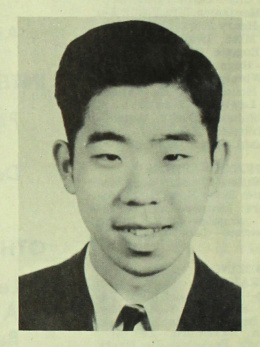Frank Shigemura
| Name | Frank Shigemura |
|---|---|
| Born | December 1 1922 |
| Died | October 20 1944 |
| Generational Identifier |
Nisei soldier who was killed during the rescue of the Lost Battalion in October 1944. A scholarship at Carleton College was established in his name based largely on donations from his parents, a story that was widely publicized in the 1950s.
Frank Masao Shigemura was born on December 1, 1922, and raised in Seattle. His parents were Takejuro Shigemura, an Issei who had come to the U.S. in 1906 and worked as a porter, and Kay Kono Shigemura, a Nisei born on Bainbridge Island . His only sibling, older sister Shigeno, was killed at age sixteen in 1931. Shigemura graduated from Broadway High School in 1941 and entered the University of Washington in the fall, majoring in economics and business administration.
As with other Japanese Americans living on the West Coast, he and his family were forcibly removed in the spring of 1942. Like most other Seattle residents, they went first to Puyallup Assembly Center , then to the Minidoka , Idaho concentration camp. Like many other Nisei students whose college education had been interrupted, he was assisted by the National Japanese American Student Relocation Council and left for Carleton College in Northfield, Minnesota, in October of 1942. There he continued his studies and immersed himself in student life. The following spring, he was among sixty students in the army's Enlisted Reserve Corps who went for officer's training, but he alone was rejected because of his ancestry. With the vigorous letter writing of Carleton Dean Lindsay Blayney, Shigemura was eventually allowed to enlist in the 442nd Regimental Combat Team , leaving campus two weeks before the end of the school year. After basic training, he went to Europe, where he was killed in action during the famed rescue of the Lost Battalion in October 1944.
After the war, Carleton published a booklet titled "They Shall Grow Not Old," paying tribute to Carleton students who had died in military service, devoting a page to each. Kay Shigemura wrote a letter to Carleton President Lawrence M. Gould expressing appreciation for the tribute and making a small donation. She continued to correspond with Gould, sending donations with each letter. The college used those donations to set up a scholarship in his name. The Shigemuras also donated money to the University of Washington, which established a prize in his name. Local journalist George Grim wrote about the story and published a piece in Reader's Digest in 1950. The Shigemuras also appeared on the TV show We, the People , in 1951, visiting Carleton College on the way back from New York.
The couple continued their donations to Carleton despite their limited income after Takejuro's retirement. After a Carleton College staffer visited them and saw the poverty they lived in, Gould wrote to them gently asking them to stop their donations to make sure they were able to care for themselves. Takejuro passed away in 1964 and Kay in 1979.
In 2010, Fred Hagstrom, the Rae Schupack Nathan Professor of Art at Carleton, produced an artist's book titled Deeply Honored about the Shigemura story, creating a series of silk screen prints using photographs and letters in the Carleton archive. A room in the college's Willis Hall is named after Shigemura and his scholarship continues to this day.
For More Information
Flood, Catherine. "Grace Unto the Humble." Scene , February 1952, 8–11.
Grim, George. " I Like It Here: The Shigemura Story. " Minneapolis Sunday Tribune , May 7, 1950. Reprinted in the Pacific Citizen , July 8, 1950, 4.
---. " Carleton College Welcomes Parents of Nisei Soldier. " Minneapolis Daily Tribune , November 30, 1951. Reprinted in the Pacific Citizen , December 8, 1951, 2.
---. "We Feel Deeply Honored." Reader's Digest , September 1950, 72.
Hagstrom, Fred. Deeply Honored . St. Paul, Minn.: Strong Silent Type Press, 2010.
---. " Deeply Honored: The Story of Frank Shigemura '45. " PowerPoint presentation for Carleton College Reunion, 2012.
Last updated Jan. 12, 2018, 6:52 p.m..

 Media
Media
